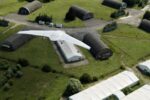In a notable example of battlefield innovation inspired by the Ukraine conflict, U.S. Army troops stationed in Europe are trialing a 3D-printed grenade dropper dubbed “Widowmaker,” mounted on the PDW C100 quadcopter drone. The test reflects growing interest within NATO forces to adapt low-cost unmanned aerial systems (UAS) for kinetic roles traditionally reserved for more expensive loitering munitions or manned platforms.
From Hobby Drone to Tactical Asset
The PDW C100 is a commercially-derived quadcopter platform developed by PDW (Precision Drone Warfare), a U.S.-based firm specializing in tactical drone solutions. While specific technical specifications remain limited in open sources, the C100 is reported to weigh approximately 1–1.5 kg and offers payload capacity sufficient for carrying small munitions such as modified M67 fragmentation grenades or VOG-17 rounds.
The drone’s design appears heavily influenced by first-person-view (FPV) racing drones and Ukrainian frontline adaptations of commercial quadcopters into strike platforms. It features carbon fiber arms, brushless motors with high thrust-to-weight ratios, and modular payload mounts compatible with custom release mechanisms like the Widowmaker.
According to imagery released from the training area in Hohenfels, Germany—part of Joint Multinational Readiness Center (JMRC) exercises—the PDW C100 was flown manually using FPV goggles and dropped dummy grenades from low altitude onto simulated enemy positions.
The ‘Widowmaker’: Additive Manufacturing Meets Battlefield Utility
The Widowmaker is a lightweight grenade release mechanism manufactured via additive manufacturing (AM), likely using fused deposition modeling (FDM) with high-strength polymers such as nylon or carbon-fiber-infused PLA+. The system attaches beneath the drone’s frame and uses servo-actuated clamps to hold and release standard fragmentation grenades.
This approach enables rapid prototyping and field-level customization—a key advantage when adapting to evolving threats or mission profiles. The name “Widowmaker,” while informal and evocative of its lethal potential, is not an official designation but has gained traction among operators testing the platform.
Field trials focused on assessing reliability under vibration loads, release accuracy during hover and dive maneuvers, and operator ease-of-use under stress conditions. Early results suggest that while precision remains limited compared to guided munitions, the system offers viable low-cost strike capability against soft targets such as infantry positions or unarmored vehicles.
Tactical Context: Lessons from Ukraine Drive NATO Innovation
The use of small drones for direct attack roles has become widespread in Ukraine since early 2022. Both Ukrainian and Russian forces have employed FPV drones equipped with improvised warheads—including RPGs, anti-tank grenades (e.g., PG-7VL), or thermobaric charges—for precision strikes at platoon level.
This shift has prompted Western militaries to reevaluate their assumptions about air dominance at tactical echelons. In response, NATO units have accelerated experimentation with organic drone capabilities—including one-way attack drones (“suicide drones”), ISR-capable quadcopters with kinetic options (like the Widowmaker), and counter-UAS systems.
U.S. Army Europe’s incorporation of these systems into training cycles reflects an intent to develop doctrine around decentralized drone employment—potentially empowering squads or platoons with autonomous strike options without needing artillery or air support tasking.
Operational Considerations and Limitations
Despite promising test results, several operational challenges remain:
- Range & Endurance: With typical flight times under 20 minutes and ranges limited by line-of-sight radio control (~5 km max), these drones are best suited for short-range engagements.
- Payload Constraints: Most quadcopters cannot carry more than one grenade-sized munition at a time; rearming requires full recovery or replacement.
- SIGINT Vulnerability: Commercial radio links used for FPV control are susceptible to jamming or interception unless upgraded with military-grade encryption modules.
- Lethality vs Cost: While cheap (~$500–$1K per unit), their effectiveness depends on operator skill and target exposure; they cannot replace artillery-scale effects.
The U.S. Army is reportedly exploring integration of AI-assisted targeting modules and encrypted digital links via STANAG-compliant radios to improve survivability and mission success rates.
A Glimpse Into Future Squad-Level Airpower
If proven effective through further testing at JMRC and other training centers like Grafenwöhr or Fort Irwin NTC, platforms like the PDW C100 + Widowmaker combo could be fielded more broadly across light infantry units. Potential applications include:
- Bunker clearing: Dropping grenades into fortified positions without risking dismounted troops.
- CQB overwatch: Providing overhead ISR during urban operations with immediate strike capability if threats emerge.
- Denying cover: Forcing enemy movement from trenches or tree lines via persistent overhead threat presence.
This trend aligns with broader U.S. Army modernization efforts under programs like Soldier Lethality Cross-Functional Team (SL-CFT) and Project Convergence—which emphasize distributed lethality through networked sensors and shooters at lower echelons.
Conclusion: From Experimentation to Doctrine?
The deployment of experimental systems like the Widowmaker-equipped PDW C100 represents more than technological curiosity—it signals doctrinal evolution toward integrating low-cost aerial lethality into combined arms maneuver concepts. As adversaries continue leveraging commercial tech for asymmetric gains, Western forces must adapt rapidly through iterative field testing and agile procurement pathways that embrace non-traditional solutions.
While still early-stage, these trials offer valuable insights into how infantry formations might wield their own “air force”—one printed in plastic but potentially decisive on tomorrow’s battlefield.










